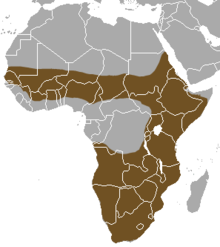Striped polecat
| Striped polecat[1] | |
|---|---|

| |
| Taxidermied specimen in the Museo Civico di Storia Naturale Giacomo Doria, Genoa | |
| Scientific classification | |
| Domain: | Eukaryota |
| Kingdom: | Animalia |
| Phylum: | Chordata |
| Class: | Mammalia |
| Order: | Carnivora |
| Family: | Mustelidae |
| Genus: | Ictonyx |
| Species: | I. striatus
|
| Binomial name | |
| Ictonyx striatus (Perry, 1810)
| |
| Subspecies[1] | |
|
(many) | |

| |
| Striped polecat range | |
The striped polecat (Ictonyx striatus), also called the African polecat, zoril, zorille, zorilla, Cape polecat, and African skunk, is a member of the
Physical characteristics
Striped polecats are about 60–70 cm (24–28 in) in length, including their tails, and 10–15 cm (3.9–5.9 in) tall to the shoulders on average. They weigh from 0.6 to 1.3 kg (1.3 to 2.9 lb), generally, with the males being the larger of the two sexes.[4] Their specific coloring varies by location. Generally they are black on the underside, white on the tail, with stripes running from their heads down their backs and on their cheeks. The legs and feet are black. Their skulls are usually around 56 mm (2.2 in) long, and they have unique face-mask coloring, often including a white spot on their heads, and white ears.[5][6] These masks are thought to serve as warnings to potential predators or other antagonists.[7]

Diet
Like other
Lifestyle and reproduction
The striped polecat is a solitary creature, often only associating with other members of its species in small family groups or for the purpose of breeding. It is nocturnal, hunting mostly at night.[3] During the day, it burrows into the brush or sleeps in the burrows of other animals.[10] Most often, striped polecats are found in habitats with large ungulate populations, because of the lower level of shrubs where these grazers occur.[2][4][11]
After conception, the gestation period for a striped polecat is about 4 weeks. During this time, the mother prepares a nest for her offspring. The newborn polecats are completely vulnerable; they are born blind, deaf, and naked.[12] Around one to five offspring are born per litter in the summer. Up to six can be supported at one time, if food is available, because the mother has six teats.[13] The mother protects her young until they are able to survive on their own.[10]
Defense mechanisms
The striped polecat is an aggressive and very territorial animal. It marks its territory with its feces and through an anal spray.[14] The spray serves as a defense against predators, in a similar manner to skunks. The spray, released by anal stink glands, temporarily blinds their adversaries and irritates the mucous membranes, resulting in an intense burning sensation.[15] Before spraying the opponent with this noxious fluid, the striped polecat often takes a deimatic (threat) stance with its back arched, rear end facing the opponent, and tail straight up in the air.[10]
Communication
Striped polecats have been known to communicate with each other using myriad verbal signals and calls. Growls act as a warning to possible predators, competitors, or other enemies to back off. High-pitched screams have been observed as signifying situations of high aggression or accompanying the spraying of anal emissions. An undulating high- to low-pitched scream has been used to convey surrender or submission to an adversary. This call has been noted to accompany the subsequent release of the loser. Conversely, a quieter undulating call has been interpreted as functioning as a friendly salutation. Mating calls are common forms of communication between the sexes. Young polecats often have a specific set of calls and signals, used in adolescence, either signifying distress or joy depending on if the mother is absent or present.[16][17]
References
- ^ OCLC 62265494.
- ^ . Retrieved 11 November 2021.
- ^ a b c Walker, Clive (1996). Signs of the Wild. Cape Town: Struik Publishers. p. 56.
- ^ ISBN 9780520272972.
- ISBN 9780521844185.
- ISBN 9789774162541.
- ^ Newman; Buesching & Wolff (2005). The function of facial masks in midguild carnivores (PDF). Oxford: Wildlife Conservation Research Unit, Dept of Zoology. p. 632.
- ^ Estes, Richard (1991). The Behavior Guide to African Mammals: Including Hoofed Mammals, Carnivores, Primates. Berkeley and Los Angeles: University of California Press. pp. 422&429.
- ^ Skinner & Chimimba (2005). The Mammals of the Southern African Subregion. Cambridge: Cambridge University Press. p. 504.
- ^ a b c Stuart & Stuart (2001). Field Guide to Mammals of Southern Africa. Cape Town: Struik Publishing. p. 132.
- .
- ^ Estes, Richard (1991). The Behavior Guide to African Mammals: Including Hoofed Mammals, Carnivores, Primates. Berkeley and Los Angeles: University of California Press. pp. 424.
- ISBN 9789774162541.
- ^ Estes, Richard (1991). The Behavior Guide to African Mammals: Including Hoofed Mammals, Carnivores, Primates. Berkeley and Los Angeles: University of California Press. pp. 422.
- ^ Estes, Richard (1991). The Behavior Guide to African Mammals: Including Hoofed Mammals, Carnivores, Primates. Berkeley and Los Angeles: University of California Press. pp. 419.
- ^ Estes, Richard (1991). The Behavior Guide to African Mammals: Including Hoofed Mammals, Carnivores, Primates. Berkeley and Los Angeles: University of California Press. pp. 431.
- PMID 930442.
- Larivière, Serge (2002). Ictonyx striatus". Mammalian Species (698):1–5.
- Nowak, Ronald M. (2005). Walker's Carnivores of the World. Baltimore: Johns Hopkins Press. ISBN 0-8018-8032-7
External links
- Ictonyx striatus on the Animal Diversity Web
- images of zorilla (Ictonyx striatus) at ARKive

